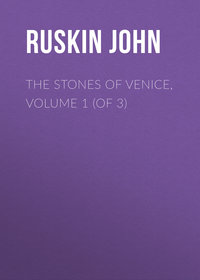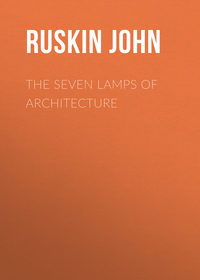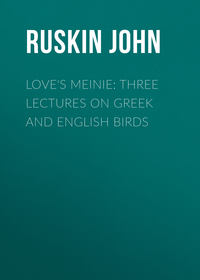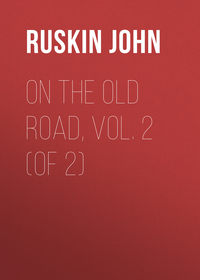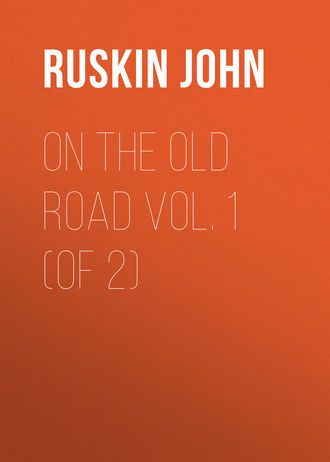 полная версия
полная версияOn the Old Road Vol. 1 (of 2)
A noble passage this, and most true, provided we distinguish always between mastery of tool together with thorough strength of workmanship, and mere neatness of outside polish or fitting of measurement, of which ancient masters are daringly scornful.
81. None of Orcagna's pupils, except Francisco Traini, attained celebrity—
"nothing in fact is known of them except their names. Had their works, however inferior, been preserved, we might have had less difficulty in establishing the links between himself and his successor in the supremacy of the Semi-Byzantine school at Florence, the Beato Fra Angelico da Fiesole.... He was born at Vicchio, near Florence, it is said in 1387, and was baptized by the name of Guido. Of a gentle nature, averse to the turmoil of the world, and pious to enthusiasm, though as free from fanaticism as his youth was innocent of vice, he determined, at the age of twenty, though well provided for in a worldly point of view, to retire to the cloister; he professed himself accordingly a brother of the monastery of S. Domenico at Fiesole in 1407, assuming his monastic name from the Apostle of love, S. John. He acquired from his residence there the distinguishing surname 'da Fiesole;' and a calmer retreat for one weary of earth and desirous of commerce with heaven would in vain be sought for;—the purity of the atmosphere, the freshness of the morning breeze, the starry clearness and delicious fragrance of the nights, the loveliness of the valley at one's feet, lengthening out, like a life of happiness, between the Apennine and the sea—with the intermingling sounds that ascend perpetually from below, softened by distance into music, and by an agreeable compromise at once giving a zest to solitude and cheating it of its loneliness—rendering Fiesole a spot which angels might alight upon by mistake in quest of paradise, a spot where it would be at once sweet to live and sweet to die."—Vol. iii., pp. 151-153.
82. Our readers must recollect that the convent where Fra Giovanni first resided is not that whose belfry tower and cypress grove crown the "top of Fésole." The Dominican convent is situated at the bottom of the slope of olives, distinguished only by its narrow and low spire; a cypress avenue recedes from it towards Florence—a stony path, leading to the ancient Badia of Fiesole, descends in front of the three-arched loggia which protects the entrance to the church. No extended prospect is open to it; though over the low wall, and through the sharp, thickset olive leaves, may be seen one silver gleam of the Arno, and, at evening, the peaks of the Carrara mountains, purple against the twilight, dark and calm, while the fire-flies glance beneath, silent and intermittent, like stars upon the rippling of mute, soft sea.
"It is by no means an easy task to adjust the chronology of Fra Angelico's works; he has affixed no dates to them, and consequently, when external evidence is wanting, we are thrown upon internal, which in his case is unusually fallacious. It is satisfactory therefore to possess a fixed date in 1433, the year in which he painted the great tabernacle for the Company of Flax-merchants, now removed to the gallery of the Uffizii. It represents the Virgin and child, with attendant Saints, on a gold ground—very dignified and noble, although the Madonna has not attained the exquisite spirituality of his later efforts. Round this tabernacle as a nucleus, may be classed a number of paintings, all of similar excellence—admirable that is to say, but not of his very best, and in which, if I mistake not, the type of the Virgin bears throughout a strong family resemblance."—Vol. iii., pp. 160, 161.
83. If the painter ever increased in power after this period (he was then forty-three), we have been unable to systematize the improvement. We much doubt whether, in his modes of execution, advance were possible. Men whose merit lies in record of natural facts, increase in knowledge; and men whose merit is in dexterity of hand increase in facility; but we much doubt whether the faculty of design, or force of feeling, increase after the age of twenty-five. By Fra Angelico, who drew always in fear and trembling, dexterous execution had been from the first repudiated; he neither needed nor sought technical knowledge of the form, and the inspiration, to which his power was owing, was not less glowing in youth than in age. The inferiority traceable (we grant) in this Madonna results not from its early date, but from Fra Angelico's incapability, always visible, of drawing the head of life size. He is, in this respect, the exact reverse of Giotto; he was essentially a miniature painter, and never attained the mastery of muscular play in the features necessary in a full-sized drawing. His habit, almost constant, of surrounding the iris of the eye by a sharp black line, is, in small figures, perfectly successful, giving a transparency and tenderness not otherwise expressible. But on a larger scale it gives a stony stare to the eyeball, which not all the tenderness of the brow and mouth can conquer or redeem.
84. Further, in this particular instance, the ear has by accident been set too far back—(Fra Angelico, drawing only from feeling, was liable to gross errors of this kind,—often, however, more beautiful than other men's truths)—and the hair removed in consequence too far off the brow; in other respects the face is very noble—still more so that of the Christ. The child stands upon the Virgin's knees,9 one hand raised in the usual attitude of benediction, the other holding a globe. The face looks straightforward, quiet, Jupiter-like, and very sublime, owing to the smallness of the features in proportion to the head, the eyes being placed at about three-sevenths of the whole height, leaving four-sevenths for the brow, and themselves only in length about one-sixth of the breadth of the face, half closed, giving a peculiar appearance of repose. The hair is short, golden, symmetrically curled, statuesque in its contour; the mouth tender and full of life: the red cross of the glory about the head of an intense ruby enamel, almost fire color; the dress brown, with golden girdle. In all the treatment Fra Angelico maintains his assertion of the authority of abstract imagination, which, depriving his subject of all material or actual being, contemplates it as retaining qualities eternal only—adorned by incorporeal splendor. The eyes of the beholder are supernaturally unsealed: and to this miraculous vision whatever is of the earth vanishes, and all things are seen endowed with an harmonious glory—the garments falling with strange, visionary grace, glowing with indefinite gold—the walls of the chamber dazzling as of a heavenly city—the mortal forms themselves impressed with divine changelessness—no domesticity—no jest—no anxiety—no expectation—no variety of action or of thought. Love, all fulfilling, and various modes of power, are alone expressed; the Virgin never shows the complacency or petty watchfulness of maternity; she sits serene, supporting the child whom she ever looks upon, as a stranger among strangers; "Behold the handmaid of the Lord" forever written upon her brow.
85. An approach to an exception in treatment is found in the Annunciation of the upper corridor of St. Mark's, most unkindly treated by our author:—
"Probably the earliest of the series—full of faults, but imbued with the sweetest feeling; there is a look of naïve curiosity, mingling with the modest and meek humility of the Virgin, which almost provokes a smile."—iii., 176.
Many a Sabbath evening of bright summer have we passed in that lonely corridor—but not to the finding of faults, nor the provoking of smiles. The angel is perhaps something less majestic than is usual with the painter; but the Virgin is only the more to be worshiped, because here, for once, set before us in the verity of life. No gorgeous robe is upon her; no lifted throne set for her; the golden border gleams faintly on the dark blue dress; the seat is drawn into the shadow of a lowly loggia. The face is of no strange, far-sought loveliness; the features might even be thought hard, and they are worn with watching, and severe, though innocent. She stoops forward with her arms folded on her bosom: no casting down of eye nor shrinking of the frame in fear; she is too earnest, too self-forgetful for either: wonder and inquiry are there, but chastened and free from doubt; meekness, yet mingled with a patient majesty; peace, yet sorrowfully sealed, as if the promise of the Angel were already underwritten by the prophecy of Simeon. They who pass and repass in the twilight of that solemn corridor, need not the adjuration inscribed beneath:—
"Virginis intactae cum veneris ante figuramPraetereundo cave ne sileatur Ave."10We in general allow the inferiority of Angelico's fresco to his tempera works; yet even that which of all these latter we think the most radiant, the Annunciation on the reliquary of Santa Maria Novella, would, we believe, if repeatedly compared with this of St. Mark's, in the end have the disadvantage. The eminent value of the tempera paintings results partly from their delicacy of line, and partly from the purity of color and force of decoration of which the material is capable.
86. The passage, to which we have before alluded, respecting Fra Angelico's color in general, is one of the most curious and fanciful in the work:—
"His coloring, on the other hand, is far more beautiful, although of questionable brilliancy. This will be found invariably the case in minds constituted like his. Spirit and Sense act on each other with livelier reciprocity the closer their approximation, the less intervention there is of Intellect. Hence the most religious and the most sensual painters have always loved the brightest colors—Spiritual Expression and a clearly defined (however inaccurate) outline forming the distinction of the former class; Animal Expression and a confused and uncertain outline (reflecting that lax morality which confounds the limits of light and darkness, right and wrong) of the latter. On the other hand, the more that Intellect, or the spirit of Form, intervenes in its severe precision, the less pure, the paler grow the colors, the nearer they tend to the hue of marble, of the bas-relief. We thus find the purest and brightest colors only in Fra Angelico's pictures, with a general predominance of blue, which we have observed to prevail more or less in so many of the Semi-Byzantine painters, and which, fanciful as it may appear, I cannot but attribute, independently of mere tradition, to an inherent, instinctive sympathy between their mental constitution and the color in question; as that of red, or of blood, may be observed to prevail among painters in whom Sense or Nature predominates over Spirit—for in this, as in all things else, the moral and the material world respond to each other as closely as shadow and substance. But, in Painting as in Morals, perfection implies the due intervention of Intellect between Spirit and Sense—of Form between Expression and Coloring—as a power at once controlling and controlled—and therefore, although acknowledging its fascination, I cannot unreservedly praise the Coloring of Fra Angelico."—Vol. iii., pp. 193, 194.
87. There is much ingenuity, and some truth, here, but the reader, as in other of Lord Lindsay's speculations, must receive his conclusions with qualification. It is the natural character of strong effects of color, as of high light, to confuse outlines; and it is a necessity in all fine harmonies of color that many tints should merge imperceptibly into their following or succeeding ones:—we believe Lord Lindsay himself would hardly wish to mark the hues of the rainbow into divided zones, or to show its edge, as of an iron arch, against the sky, in order that it might no longer reflect (a reflection of which we profess ourselves up to this moment altogether unconscious) "that lax morality which confounds the limits of right and wrong." Again, there is a character of energy in all warm colors, as of repose in cold, which necessarily causes the former to be preferred by painters of savage subject—that is to say, commonly by the coarsest and most degraded;—but when sensuality is free from ferocity, it leans to blue more than to red (as especially in the flesh tints of Guido), and when intellect prevails over this sensuality, its first step is invariably to put more red into every color, and so "rubor est virtutis color." We hardly think Lord Lindsay would willingly include Luca Giordano among his spiritual painters, though that artist's servant was materially enriched by washing the ultramarine from the brushes with which he painted the Ricardi palace; nor would he, we believe, degrade Ghirlandajo to fellowship with the herd of the sensual, though in the fresco of the vision of Zacharias there are seventeen different reds in large masses, and not a shade of blue. The fact is, there is no color of the spectrum, as there is no note of music, whose key and prevalence may not be made pure in expression, and elevating in influence, by a great and good painter, or degraded to unhallowed purpose by a base one.
88. We are sorry that our author "cannot unreservedly praise the coloring of Angelico;" but he is again curbed by his unhappy system of balanced perfectibility, and must quarrel with the gentle monk because he finds not in him the flames of Giorgione, nor the tempering of Titian, nor the melody of Cagliari. This curb of perfection we took between our teeth from the first, and we will give up our hearts to Angelico without drawback or reservation. His color is, in its sphere and to its purpose, as perfect as human work may be: wrought to radiance beyond that of the ruby and opal, its inartificialness prevents it from arresting the attention it is intended only to direct; were it composed with more science it would become vulgar from the loss of its unconsciousness; if richer, it must have parted with its purity, if deeper, with its joyfulness, if more subdued, with its sincerity. Passages are, indeed, sometimes unsuccessful; but it is to be judged in its rapture, and forgiven in its fall: he who works by law and system may be blamed when he sinks below the line above which he proposes no elevation, but to him whose eyes are on a mark far off, and whose efforts are impulsive, and to the utmost of his strength, we may not unkindly count the slips of his sometime descent into the valley of humiliation.
89. The concluding notice of Angelico is true and interesting, though rendered obscure by useless recurrence to the favorite theory.
"Such are the surviving works of a painter, who has recently been as unduly extolled as he had for three centuries past been unduly depreciated,—depreciated, through the amalgamation during those centuries of the principle of which he was the representative with baser, or at least less precious matter—extolled, through the recurrence to that principle, in its pure, unsophisticated essence, in the present —in a word, to the simple Imaginative Christianity of the middle ages, as opposed to the complex Reasoning Christianity of recent times. Creeds therefore are at issue, and no exclusive partisan, neither Catholic nor Protestant in the absolute sense of the terms, can fairly appreciate Fra Angelico. Nevertheless, to those who regard society as progressive through the gradual development of the component elements of human nature, and who believe that Providence has accommodated the mind of man, individually, to the perception of half-truths only, in order to create that antagonism from which Truth is generated in the abstract, and by which the progression is effected, his rank and position in art are clear and definite. All that Spirit could achieve by herself, anterior to that struggle with Intellect and Sense which she must in all cases pass through in order to work out her destiny, was accomplished by him. Last and most gifted of a long and imaginative race—the heir of their experience, with collateral advantages which they possessed not—and flourishing at the moment when the transition was actually taking place from the youth to the early manhood of Europe; he gave full, unreserved, and enthusiastic expression to that Love and Hope which had winged the Faith of Christendom in her flight towards heaven for fourteen centuries,—to those yearnings of the Heart and the Imagination which ever precede, in Universal as well as Individual development, the severer and more chastened intelligence of Reason."—Vol. iii., pp. 188-190.
90. We must again repeat that if our author wishes to be truly serviceable to the schools of England, he must express himself in terms requiring less laborious translation. Clearing the above statement of its mysticism and metaphor, it amounts only to this,—that Fra Angelico was a man of (humanly speaking) perfect piety—humility, charity, and faith—that he never employed his art but as a means of expressing his love to God and man, and with the view, single, simple, and straightforward, of glory to the Creator, and good to the Creature. Every quality or subject of art by which these ends were not to be attained, or to be attained secondarily only, he rejected; from all study of art, as such, he withdrew; whatever might merely please the eye, or interest the intellect, he despised, and refused; he used his colors and lines, as David his harp, after a kingly fashion, for purposes of praise and not of science. To this grace and gift of holiness were added, those of a fervent imagination, vivid invention, keen sense of loveliness in lines and colors, unwearied energy, and to all these gifts the crowning one of quietness of life and mind, while yet his convent-cell was at first within view, and afterwards in the center, of a city which had lead of all the world in Intellect, and in whose streets he might see daily and hourly the noblest setting of manly features. It would perhaps be well to wait until we find another man thus actuated, thus endowed, and thus circumstanced, before we speak of "unduly extolling" the works of Fra Angelico.
91. His artistical attainments, as might be conjectured, are nothing more than the development, through practice, of his natural powers in accordance with his sacred instincts. His power of expression by bodily gesture is greater even than Giotto's, wherever he could feel or comprehend the passion to be expressed; but so inherent in him was his holy tranquillity of mind, that he could not by any exertion, even for a moment, conceive either agitation, doubt, or fear—and all the actions proceeding from such passions, or, à fortiori, from any yet more criminal, are absurdly and powerlessly portrayed by him; while contrariwise, every gesture, consistent with emotion pure and saintly, is rendered with an intensity of truth to which there is no existing parallel; the expression being carried out into every bend of the hand, every undulation of the arm, shoulder, and neck, every fold of the dress and every wave of the hair. His drawing of movement is subject to the same influence; vulgar or vicious motion he cannot represent; his running, falling, or struggling figures are drawn with childish incapability; but give him for his scene the pavement of heaven, or pastures of Paradise, and for his subject the "inoffensive pace" of glorified souls, or the spiritual speed of Angels, and Michael Angelo alone can contend with him in majesty,—in grace and musical continuousness of motion, no one. The inspiration was in some degree caught by his pupil Benozzo, but thenceforward forever lost. The angels of Perugino appear to be let down by cords and moved by wires; that of Titian, in the sacrifice of Isaac, kicks like an awkward swimmer; Raphael's Moses and Elias of the Transfiguration are cramped at the knees; and the flight of Domenichino's angels is a sprawl paralyzed. The authority of Tintoret over movement is, on the other hand, too unlimited; the descent of his angels is the swoop of a whirlwind or the fall of a thunderbolt; his mortal impulses are oftener impetuous than pathetic, and majestic more than melodious.
92. But it is difficult by words to convey to the reader unacquainted with Angelico's works, any idea of the thoughtful variety of his rendering of movement—Earnest haste of girded faith in the Flight into Egypt, the haste of obedience, not of fear; and unweariedness, but through spiritual support, and not in human strength—Swift obedience of passive earth to the call of its Creator, in the Resurrection of Lazarus—March of meditative gladness in the following of the Apostles down the Mount of Olives—Rush of adoration breaking through the chains and shadows of death, in the Spirits in Prison. Pacing of mighty angels above the Firmament, poised on their upright wings, half opened, broad, bright, quiet, like eastern clouds before the sun is up;—or going forth, with timbrels and with dances, of souls more than conquerors, beside the shore of the last great Red Sea, the sea of glass mingled with fire, hand knit with hand, and voice with voice, the joyful winds of heaven following the measure of their motion, and the flowers of the new earth looking on, like stars pausing in their courses.
93. And yet all this is but the lowest part and narrowest reach of Angelico's conceptions. Joy and gentleness, patience and power, he could indicate by gesture—but Devotion could be told by the countenance only. There seems to have been always a stern limit by which the thoughts of other men were stayed; the religion that was painted even by Perugino, Francia, and Bellini, was finite in its spirit—the religion of earthly beings, checked, not indeed by the corruption, but by the veil and the sorrow of clay. But with Fra Angelico the glory of the countenance reaches to actual transfiguration; eyes that see no more darkly, incapable of all tears, foreheads flaming, like Belshazzar's marble wall, with the writing of the Father's name upon them, lips tremulous with love, and crimson with the light of the coals of the altar—and all this loveliness, thus enthusiastic and ineffable, yet sealed with the stability which the coming and going of ages as countless as sea-sand cannot dim nor weary, and bathed by an ever flowing river of holy thought, with God for its source, God for its shore, and God for its ocean.
94. We speak in no inconsiderate enthusiasm. We feel assured that to any person of just feeling who devotes sufficient time to the examination of these works, all terms of description must seem derogatory. Where such ends as these have been reached, it ill becomes us to speak of minor deficiencies as either to be blamed or regretted: it cannot be determined how far even what we deprecate may be accessory to our delight, nor by what intricate involution what we deplore may be connected with what we love. Every good that nature herself bestows, or accomplishes, is given with a counterpoise, or gained at a sacrifice; nor is it to be expected of Man that he should win the hardest battles and tread the narrowest paths, without the betrayal of a weakness, or the acknowledgment of an error.
95. With this final warning against our author's hesitating approbation of what is greatest and best, we must close our specific examination of the mode in which his design has been worked out. We have done enough to set the reader upon his guard against whatever appears slight or inconsiderate in his theory or statements, and with the more severity, because this was alone wanting to render the book one of the most valuable gifts which Art has ever received. Of the translations from the lives of the saints we have hardly spoken; they are gracefully rendered, and all of them highly interesting—but we could wish to see these, and the enumerations of fresco subjects11 with which the other volumes are in great part occupied, published separately for the convenience of travelers in Italy. They are something out of place in a work like that before us. For the rest, we might have more interested the reader, and gratified ourselves, by setting before him some of the many passages of tender feeling and earnest eloquence with which the volumes are replete—but we felt it necessary rather to anticipate the hesitation with which they were liable to be received, and set limits to the halo of fancy by which their light is obscured—though enlarged. One or two paragraphs, however, of the closing chapter must be given before we part:—
96. "What a scene of beauty, what a flower-garden of art—how bright and how varied—must Italy have presented at the commencement of the sixteenth century, at the death of Raphael! The sacrileges we lament took place for the most part after that period; hundreds of frescoes, not merely of Giotto and those other elders of Christian Art, but of Gentile da Fabriano, Pietro della Francesca, Perugino and their compeers, were still existing, charming the eye, elevating the mind, and warming the heart. Now alas! few comparatively and fading are the relics of those great and good men. While Dante's voice rings as clear as ever, communing with us as friend with friend, theirs is dying gradually away, fainter and fainter, like the farewell of a spirit. Flaking off the walls, uncared for and neglected save in a few rare instances, scarce one of their frescoes will survive the century, and the labors of the next may not improbably be directed to the recovery and restoration of such as may still slumber beneath the whitewash and the daubs with which the Bronzinos and Zuccheros 'et id genus omne' have unconsciously sealed them up for posterity—their best title to our gratitude.—But why not begin at once? at all events in the instances numberless, where merely whitewash interposes between us and them.




